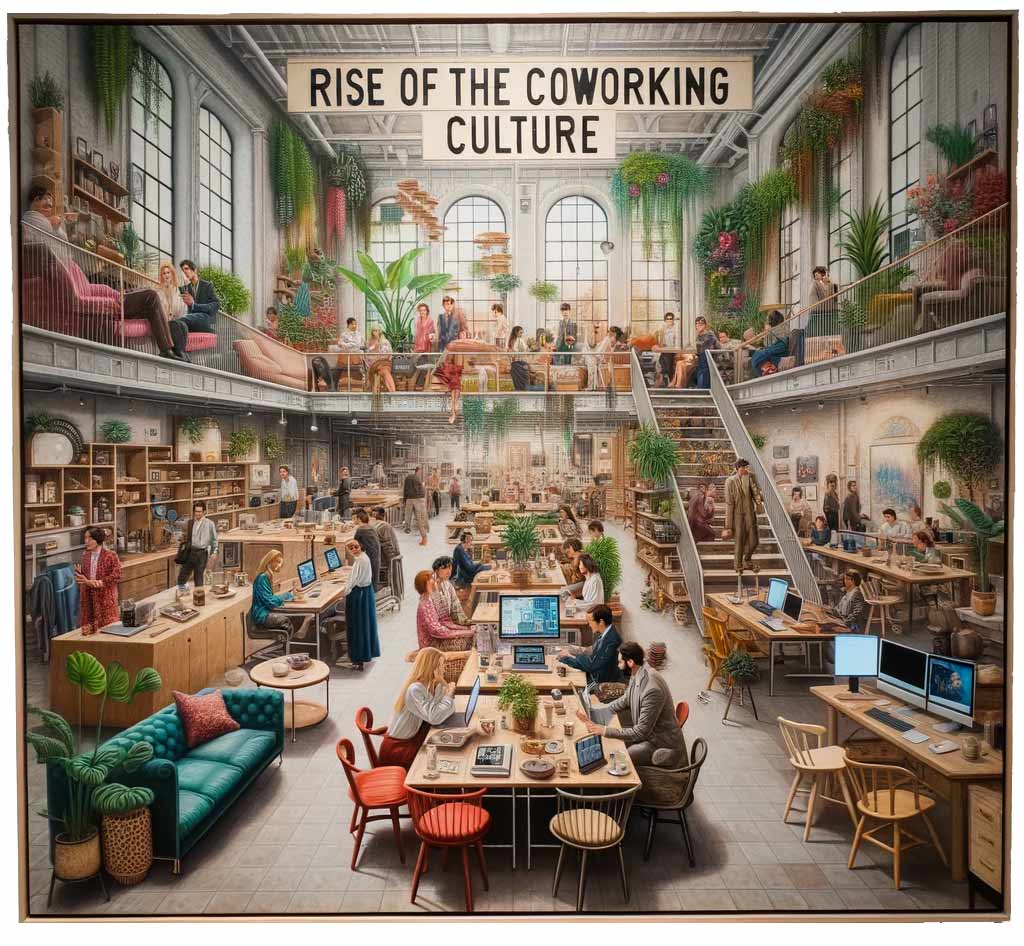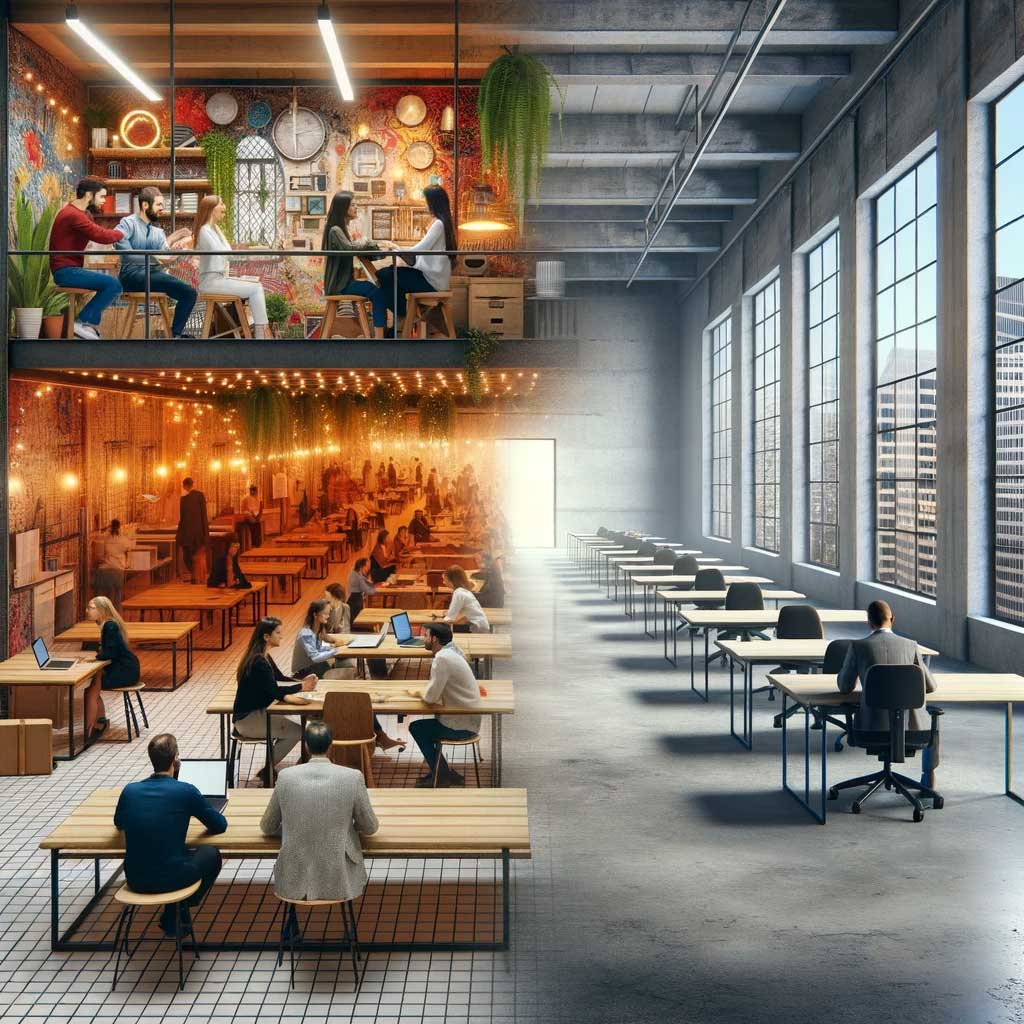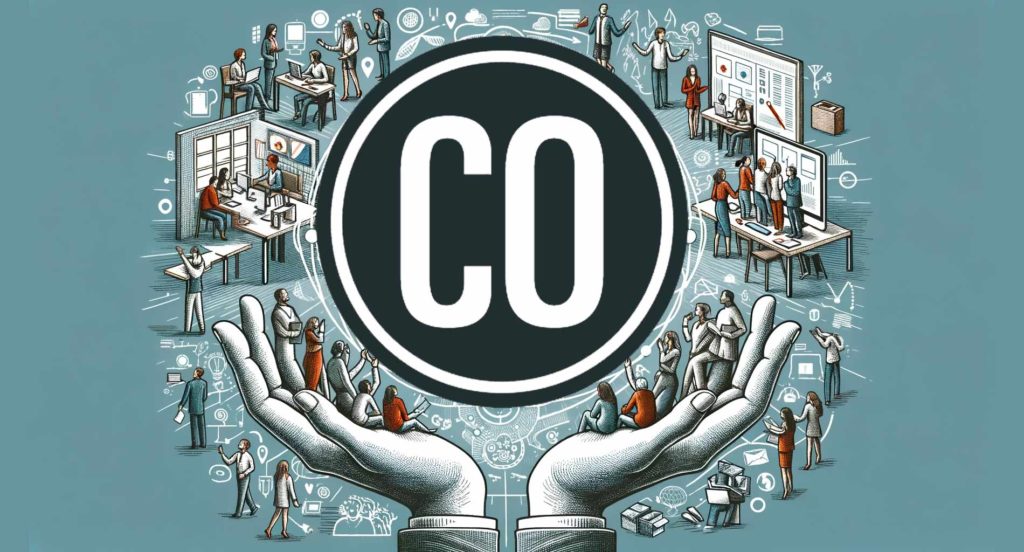A decade ago, he cofounded the first full-service global coworking consultancy, OpenWork Agency, which in April 2023 spun off to create CoworkingConsulting.com. David and his partners have helped clients launch coworking businesses in places such as Nairobi, Singapore, Bahamas, Dubai, and numerous locations across the USA.
Let's Connect on LinkedIn
- Introducing Our Fractional Coworking Executive Service: Transform Underutilized Office Spaces into High-Occupancy, Revenue-Generating Assets - September 26, 2024
- Community Manager 3.0: Why Your Space May Need a Coworking Executive - December 14, 2023
- The Unseen Discriminatory Factors of a Mandated RTO Policy - November 8, 2023
WeWork’s Bankruptcy: A Historical Paradox in Coworking
Disruption, Disillusion, and the Quest for Authenticity
This morning, a coworking client sent me a Reuters article about the impending bankruptcy of WeWork. As someone who has been in the coworking industry since 2008, two years prior to WeWork, and whose businesses are tied to coworking and workplace culture, I feel compelled to comment on this situation.
The Rise and Fall of WeWork
WeWork’s journey is a tale of rapid commercialization and global expansion. It became a symbol of a shift from coworking’s original values to a model driven by financial metrics and scale. This shift, while catapulting coworking into global recognition, also diluted the essence of what coworking stood for. The news of WeWork’s bankruptcy presents a paradox: a company that once symbolized the future of work now facing its own existential crisis, mirroring the broader identity crisis in the modern workforce. With people juggling side gigs or even “polyworking” with multiple full-time jobs, all the while managers exert increasing pressure, the landscape of work is undergoing a profound transformation.

Misconception About WeWork and Coworking
There’s a misconception that WeWork epitomizes the entire coworking industry. In reality, WeWork primarily serves Fortune 500 companies, often occupying large spaces of 50,000 square feet or more in downtown locations. This contrasts with many independent operators who manage smaller spaces and cater to freelancers, small businesses, and startups.
WeWork’s shift to larger footprints and corporate clients marks a departure from traditional coworking’s community-centric ethos. While independent operators focus on personal relationships and small teams, WeWork’s model includes team suites for large groups and employs front desk attendants with different success metrics. This distinction highlights a significant divergence from the foundational principles of coworking.
The Global Impact of WeWork
WeWork’s story has inspired entrepreneurs worldwide to create spaces that resonate with their communities. The industry stands at an opportunity-laden moment of self inquiry- a future that can cater to users from all sizes and types, who all want flexibility, cost-savings, choice, and perhaps most importantly – a philosophical desire to find fulfillment in their professional lives. How do we build new models that reflect our fluid work and life dynamics? As Yogi Berra, who appeared in 21 World Series as a player, coach and manager, paradoxically remarked, “When you come to a fork in the road, take it.” And that’s where it seems we all are, as 2024 peeks its head around the turn.
Irony in Coworking Industry Dynamics
Launching a coworking business during WeWork’s bankruptcy is ironic, yet the demand for flexible workspaces is at an all-time high. Companies are wary of long-term real estate commitments, leading to increased interest in flexible models from firms like CBRE, Colliers, and JLL. These companies have been proponents of the flex workspace model for years, mainly because their clients, primarily large corporations, have been expressing interest in less risky real estate investments for their workforce. This trend has forced them to evolve their services and business models to cater to this growing demand.
Furniture companies like Steelcase, Herman Miller, and innovative marketplaces like Canoa, and others have also been heavily involved in embracing the shared workspace industry. They’ve seen the demand for these models in spaces increase vastly and have created entire lines of furniture specifically designed for these flexible models. Additionally, architects are experiencing an increase in demand for creating flex spaces, reflecting a broader shift in the industry where traditional players are rethinking their strategies to align with the evolving needs of the modern workforce. This convergence of interests from various sectors underscores the significant impact and potential of the coworking model in shaping the future of workspaces.
Coworking: More Than WeWork
When I tell people I am a coworking consultant, they often ask, “Oh, do you work for WeWork?” WeWork has given the industry and the coworking model the fame it needed to exist where it is today. However, the idea of the industry is not just WeWork.
There are currently over 30,000 coworking spaces in the world, and of those, WeWork does have the largest presence with about 700 locations.
The Birth and Evolution of Coworking Spaces
The concept of coworking can be traced back to the 1990s, but it was in 2005 that the first official coworking space opened in San Francisco. Here’s a breakdown of the phases of coworking history:
-
- Phase 1 (2005-2010): The Emergence – Early coworking spaces were grassroots initiatives, often started by freelancers or entrepreneurs looking for a community-centric workspace. These spaces were basic, focusing on open desks and community events.
-
-
- Phase 2 (2010-2015): Expansion & Diversification – As the demand grew, coworking spaces began to expand in size and number. This phase saw the rise of major players like WeWork. Spaces began to offer private offices, dedicated desks, and more amenities. Niche coworking spaces, catering to specific industries or demographics, also emerged.
-
- Phase 3 (2015-2020): Global Proliferation – Coworking went global, with spaces opening in cities around the world. Large corporations began to see the value in coworking, leading to the rise of enterprise coworking solutions. This phase also saw increased investment and valuations in the coworking industry.
-
- Phase 4 (2020-Present): Adaptation & Resilience – The COVID-19 pandemic brought challenges but also highlighted the value of flexibility. While some spaces struggled, the industry as a whole adapted, with an emphasis on safety, hybrid work models, and more localized solutions.
Coworking’s Core Values: A Reflection and a Question
Originally, coworking stood for Community, Openness, Collaboration, Sustainability, Accessibility. These values are now at risk in the evolving real estate market. Many pioneers feel disillusioned, seeing the coworking ethos diluted in favor of flexible workspace models focused more on profit than community. This shift sparks debate: can these modern flex spaces truly embody the authentic spirit of coworking? The industry faces a critical moment of introspection, striving to reconnect with its foundational principles.
Yet, a crucial question looms: If these spaces lose the authentic spirit of coworking, will they still attract the modern workforce, fuel sustainable business models, and meet financial projections? The answer may shape the future of coworking.
Coworking’s Resilience: Beyond the WeWork Narrative; Emerging Industry Trends
The coworking industry has been a topic of much discussion, especially with the rise and fall of WeWork, its most prominent player. The narrative surrounding WeWork’s challenges has led many to question the viability of the coworking model. However, a deeper dive reveals a more nuanced picture. Let’s explore the state of coworking beyond the WeWork story.
-
- WeWork’s Challenges: An Anomaly, Not a Norm
While WeWork’s rapid expansion, high lease liabilities, and corporate governance issues contributed to its financial challenges, it’s essential to understand that WeWork’s model and decisions do not represent the entire coworking industry. Many coworking spaces operate sustainably, with diversified revenue streams and a focus on community building.
-
-
- The Broader Coworking Landscape: Thriving and Diverse
Despite WeWork’s challenges, the coworking industry continues to grow. According to a report by Statista, the number of coworking spaces worldwide is expected to reach over 40,000 by 2024, up from around 22,400 in 2019. This growth indicates a demand for flexible workspaces, especially in the wake of the pandemic, which has reshaped how and where we work.
- The Broader Coworking Landscape: Thriving and Diverse
-
- The Appeal of Flexibility
The global shift towards remote and hybrid work models has accelerated the demand for flexible workspaces. Companies are now more open to allowing employees to work from locations that boost their productivity. Coworking spaces, with their flexible terms and diverse environments, fit this bill perfectly.
- The Appeal of Flexibility
-
- Diversified Revenue Streams
Successful coworking spaces have evolved to offer more than just a desk. They provide a range of services, from private offices and meeting rooms to virtual mailing addresses, event spaces, and coaching programs. This diversification minimizes risk and maximizes opportunities, ensuring the spaces aren’t solely reliant on desk rentals.
- Diversified Revenue Streams
-
- Community and Collaboration
Beyond just a workspace, modern coworking spaces are hubs of entrepreneurial energy. They foster networking, collaboration, and community building. This emphasis on community is a significant draw for freelancers, startups, and even established businesses looking to tap into a network of innovators.
- Community and Collaboration
-
- Strategic Locations
While WeWork predominantly targeted high-rent downtown locations, many coworking spaces are exploring suburban and retail-friendly officing. Positioned near modern conveniences like grocery stores, gyms, and shopping districts, these spaces offer accessibility and cater to a demographic seeking workspaces closer to home.The narrative surrounding WeWork’s challenges should not overshadow the broader success and resilience of the coworking industry. As the world of work continues to evolve, coworking spaces, with their flexibility, community focus, and diversified services, are well poised to meet the changing demands of businesses and professionals. The industry’s growth and adaptability suggest that coworking is not just surviving but thriving in today’s dynamic business landscape.
- Strategic Locations
The Physical vs. Fluid Nature of Workspaces
The coworking industry has evolved from simple setups to sophisticated, multi-million dollar environments. Initially, a fresh coat of paint and basic furniture sufficed. Now, driven by industry giants like WeWork, coworking spaces have become amenity-rich ecosystems, catering to the diverse needs of the modern workforce.
This upscale shift reflects a change in asset management strategies. Traditional office buildings are being transformed into dynamic environments, balancing work with collaboration and community. However, this raises questions about maintaining the authentic spirit of coworking amidst luxury.
Creating these spaces involves significant financial and logistical complexities. A profitable pro forma is essential for securing financial backing. WeWork’s revenue per square foot set a precedent, and asset managers are keen to replicate this success. The challenge lies in creating spaces that are inspiring, inclusive, and financially sustainable, ensuring they cater to the evolving demands of the modern workforce while remaining true to the core principles of coworking.

WeWork’s Disruptive Artistry

WeWork impressively put together a scalable strategy to launch and deploy spaces in unimaginable ways. The core competency that WeWork lived in was disruption and innovation. What they were able to do with the commercial real estate industry in terms of disrupting the financial model and physical office is astounding.
They had the smartest people working for them and they were investing in not just real estate, but in new ways of thinking.
Most importantly, they were able to showcase the coworking model to the world through powerful marketing campaigns and partnerships. Their brand was their greatest feature and it was the greatest asset to the entire coworking industry at large. They were able to help the world understand and become aware of coworking. As the French impressionist, Edgar Degas said. “Art is not what you see, but what you make others see.” And WeWork was filled with master artists.
Diverse Reasons Behind Creating Coworking Spaces
Who builds coworking spaces? It’s real estate developers, mostly. Nowadays, for the most part people get into the coworking industry because of the profitable revenue per square foot. Real estate professionals often think in terms of numbers, and even when I worked with clients over the years, it’s very seldom that the discussions go in-depth on the value pillars and the community pillars that actually make their space a great place to work. But let’s not forget the innovative entrepreneurs out there also driving the industry. These are the individuals who see gaps in the market and leap to fill them. They’re the ones who bring to life coworking spaces that cater to niche industries, offer unique amenities, or serve specific demographics. Their drive isn’t just financial; it’s fueled by a passion for community building and a desire to create something that resonates with people on a deeper level. These entrepreneurs blend their business acumen with a genuine commitment to creating spaces that aren’t just profitable but also meaningful and impactful for their members.
Personal Experience and Reflections
Reflecting on my journey, from running a coworking space to consulting globally, I’ve seen the industry evolve. One time, I was in Shanghai on a business trip for a coworking client based in Singapore. I remember visiting a space called “WeWork 3.0” in the automotive district. It was a copy/paste, not an actual WeWork. The design was impeccable, but the air was stale, the silence stark, and the energy of the people just gone. It felt quite hollow.
This experience highlighted that the magic of coworking and the magic of WeWork is more than just space.
It’s about all the elements that go into deploying and running a hospitality-driven modern workplace for a modern workforce.
Coworking’s Core Values vs. WeWork’s Shift
The coworking model is fundamentally about fostering community, collaboration, and shared purpose. However, WeWork’s journey, especially as it transitioned into a publicly traded company, diverged significantly from these core principles.
As WeWork’s valuation soared to $44 billion, it became more than just a coworking company; it became a corporate icon. But this rise was accompanied by a shift in focus. The company began to prioritize financial metrics and scalability, which gradually overshadowed the community ethos central to coworking. The pressures of satisfying shareholders and the complexities of operating in the public eye contributed to this shift.
-
- Unsustainable Model: WeWork’s strategy of long-term leases and short-term rentals was inherently risky. This model, focused more on rapid expansion than financial stability, was a significant departure from the community-driven ethos of coworking.
-
-
- Financial Instability: The company’s staggering losses and cash burn rate were unsustainable. In pursuit of rapid growth, WeWork overlooked financial prudence, leading to a precarious financial position. This approach was far removed from the sustainable, value-driven model that coworking originally represented.
-
- Governance Issues: WeWork’s corporate governance raised concerns, with conflicts of interest and a concentration of power in the hands of its founders. This governance structure was far removed from the community-driven ethos of coworking.
-
- Leadership and Vision: Leadership changes and departures signaled internal turmoil. The company’s shift from its original mission of fostering community and collaboration to a real estate-centric approach alienated its core audience.
Ironically, even as WeWork’s co-founder Adam Neumann infused the company’s SEC filings with spiritual phrases like “elevate the world’s consciousness,” the company’s actions increasingly reflected an agenda less focused on integrity and sustainability and more focused on growth and perception of success.
WeWork’s bankruptcy serves as a cautionary tale for the coworking industry, underscoring the dangers of letting financial objectives overshadow the fundamental values of community, collaboration, and shared purpose. For the industry at large, it’s a poignant reminder to uphold the principles that define the true spirit of coworking, even amidst financial allure and market pressures.

An Era of Disruption and Disillusion
In this era of disruption and disillusion, there lies an opportunity to embrace authenticity and build a future that aligns with our deepest aspirations and values.
WeWork, once a shining light of innovation and excitement in the coworking industry, has become a symbol of disillusionment (for investors and the public at large).
Initially, it stood for more than just shared workspaces; it represented a new way of working, a community-driven approach, and a break from traditional office culture. However, over time, as the company scaled up to meet shareholder expectations, it became a hollow version of its original self. The brand that once inspired many gradually lost its essence, becoming a reflection of the compromises and shifts that often accompany rapid growth and public market pressures.
Parallel Disruptions: Reconnecting with Our ‘Why’
This disillusionment with WeWork mirrors a broader disruption many of us are experiencing in our professional and personal lives.
In a world that’s constantly changing, where economic pressures and societal shifts are the norm, there’s a growing need to reconnect with our ‘why’—the fundamental reasons that drive our choices and define our purpose.
Just as WeWork drifted away from its original mission, many individuals find themselves at a crossroads, seeking to realign their work and life with their core values and aspirations.
The Quest for Authenticity and Purpose
The story of WeWork’s rise and fall serves as a cautionary tale about the importance of staying true to one’s foundational principles. In the coworking industry and beyond, there’s a growing hunger for authenticity, for workspaces and work cultures that resonate with our deeper needs for meaning and connection. The disillusionment isn’t just about a brand; it’s about a collective yearning for a more purpose-driven approach to work and life.
We Work Together
I work. You work. But together, we work, and the world can work, together.
The best shot that we have to lasso the potential energy and manifest the prosperous futures that we all want is to work together. And that’s what coworking is all about. It’s about working together. It’s about being together. It’s about creating together. It’s about thriving together. And that’s the future of work.


this article serves as a valuable reminder of the essence of coworking and the importance of staying true to its founding principles. It’s encouraging to see the resilience of the coworking industry despite challenges, and I’m excited to see how it continues to adapt and thrive in the future.